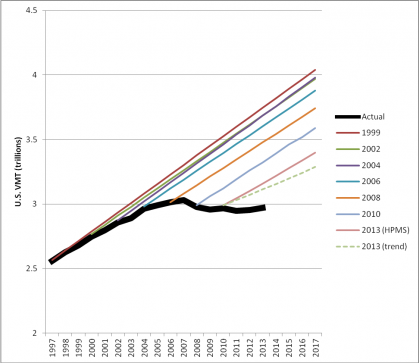The USDOT's "Conditions & Performance Report" predicts that VMT will grow between 1.36% and 1.85%, although current demographic and economic trends have resulted in flat or negative growth in recent years. Why won't they learn?

In December, as USDOT was preparing its updated Conditions & Performance report. Researchers at the State Smart Transportation Initiative took a look back at previous reports and found a consistent pattern of overestimates of motor-vehicle travel demand. They wondered about the new estimates: Will they be accurate this time?
Now we know. The answer is “no.”
The 2013 Conditions & Performance report, released 28 February 2014, does contain a nod to the 21stcentury trend of easing travel demand (expressed as vehicle-miles traveled or VMT). It provides two future trend lines for decision makers to consider.
As in past reports, one trend line is based on the Highway Performance Monitoring System (HPMS). This amounts to rolled-up estimates of demand from states and local transportation agencies. It estimates VMT growth at 1.85 percent annually—the same as that presented in the most recent 2010 report.
The other trend line, new for this report, is based on actual VMT growth from 1995 to 2010. It estimates VMT growth at a reduced rate of 1.36 percent annually. The three years since 2010 have all seen much lower growth than either estimate would suggest, -0.7 percent, 0.3 percent, and 0.6 percent respectively. So by 2013, the year the new report is dated, the new C&P was already estimating VMT that was 5 to 6 percent higher than actual, depending on which of the assumptions is used.

Figure 1. VMT predictions from USDOT’s Conditions & Performance (C&P) reports, compared with actual VMT from FHWA’s Travel Volume Trends reports.
That the HPMS-based estimate is unchanged indicates that many state and local DOTs have not adjusted their estimates to account for easing demand, continuing to base “needs” assessments for highway capacity on trend lines that overshoot reality. That both the HPMS and 15-year trend estimates continue to overstate highway travel calls into question budgeting conclusions in the report, as well as many similar conclusions at the state and local levels. The C&P report finds that the reduction from the HPMS to the 15-year trend implies a 24 percent drop, or $21 billion, in annual spending needed to maintain current roadway conditions and performance.
As the C&P points out, pavement conditions improve in the 15-year trend scenario, partly because of less wear and tear, but also because of changing investment priorities. From the report: “the lower projected future VMT causes HERS [Highway Economic Requirements System] to shift resources from capacity expansion to pavement improvements, resulting in better pavements.”
Had the report based estimates on more current historic data—e.g., VMT trends for 2003-13, which grew at one-fifth the USDOT’s 1995-2010 estimate—the cost estimates would have dropped by tens of billions more, reducing pressure on budgets while freeing up funds to bring the existing system to a state of good repair.
FULL STORY: U.S. DOT highway travel demand estimates continue to overshoot reality

Planetizen Federal Action Tracker
A weekly monitor of how Trump’s orders and actions are impacting planners and planning in America.

Chicago’s Ghost Rails
Just beneath the surface of the modern city lie the remnants of its expansive early 20th-century streetcar system.

Amtrak Cutting Jobs, Funding to High-Speed Rail
The agency plans to cut 10 percent of its workforce and has confirmed it will not fund new high-speed rail projects.

Ohio Forces Data Centers to Prepay for Power
Utilities are calling on states to hold data center operators responsible for new energy demands to prevent leaving consumers on the hook for their bills.

MARTA CEO Steps Down Amid Citizenship Concerns
MARTA’s board announced Thursday that its chief, who is from Canada, is resigning due to questions about his immigration status.

Silicon Valley ‘Bike Superhighway’ Awarded $14M State Grant
A Caltrans grant brings the 10-mile Central Bikeway project connecting Santa Clara and East San Jose closer to fruition.
Urban Design for Planners 1: Software Tools
This six-course series explores essential urban design concepts using open source software and equips planners with the tools they need to participate fully in the urban design process.
Planning for Universal Design
Learn the tools for implementing Universal Design in planning regulations.
Caltrans
City of Fort Worth
Mpact (founded as Rail~Volution)
City of Camden Redevelopment Agency
City of Astoria
City of Portland
City of Laramie




























